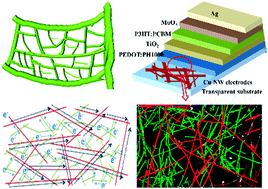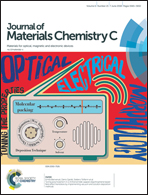‘Leaf vein’ inspired structural design of Cu nanowire electrodes for the optimization of organic solar cells†
Abstract
Cu nanowire electrodes have drawn lots of attention recently due to their potential applications in touch panels, organic solar cells and organic light-emitting diodes. The optimization of Cu nanowire electrodes is of great importance in improving the performance of devices based on them. The optical and electrical properties and surface coverage fractions of electrodes composed of nanowires with similar aspect ratios but different geometrical parameters (lengths and diameters) were thoroughly characterized, which enabled the optimization of Cu nanowire electrodes through structural design. Inspired by the grading structure of leaf veins, hybrid Cu nanowire electrodes composed of nanowires with similar aspect ratios but different geometrical parameters were constructed. By combining the advantages of nanowires with various diameters, hybrid Cu nanowire electrodes with improved conductivity at high optical transparency and large effective conducting areas were fabricated. These properties would effectively benefit the effective collection of charge carriers in solar cells. On the basis of these hybrid nanowire electrodes, organic solar cells with enhanced power conversion efficiency were constructed, which cast new light on the optimization of devices based on Cu nanowires.



 Please wait while we load your content...
Please wait while we load your content...